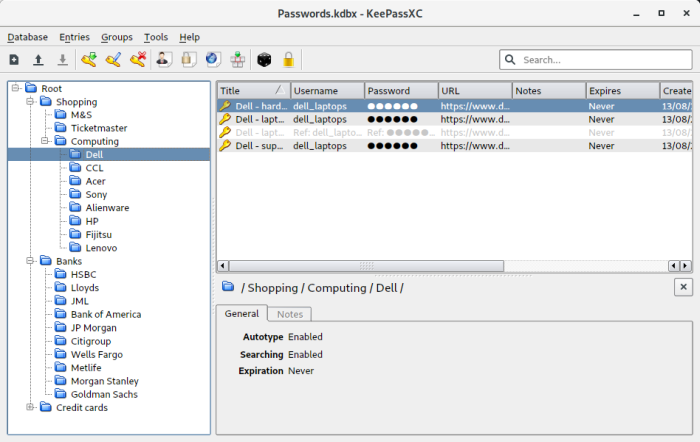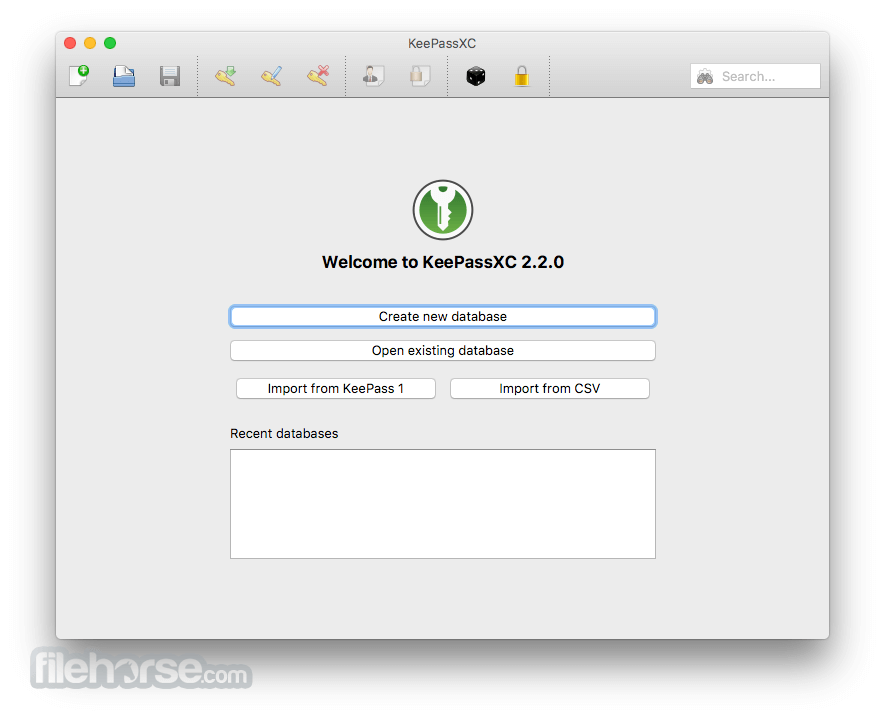The Official KeePassX Homepage
KeePassXC is a cross-platform community-driven port of the Windows application “Keepass Password Safe”. Windows linux cross-platform osx password-manager yubikey keepass C 824 10,129 584 (1 issue needs help) 30 Updated 6 hours ago. KeePassX is an application for people with extremly high demands on secure personal data management. It has a light interface, is cross platform and published under the terms of the GNU General Public License. KeePassX saves many different information e.g. User names, passwords, urls, attachments and comments in one single database. KeePassXC Desktop Application KeePassXC is a fork of a fork, most recently to spur the development of what was KeePassXC that had very slow development, and is now dormant. The ability to do OTP was originally a plugin for the original KeePass (which supports plugins). KeePassXC is an application for people with extremely high demands on secure personal data management. It has a light interface, is cross-platform and published under the terms of the GNU General Public License. Changes in version 2.6.4 Automatically adapt to light/dark system theme changes (Windows/macOS only) #6034.
Just in case you do not know what KeePassX is, here is a short description…
KeePassX is an application for people with extremly high demands on secure personal data management. It has a light interface, is cross platform and published under the terms of the GNU General Public License.
KeePassX saves many different information e.g. user names, passwords, urls, attachments and comments in one single database. For a better management user-defined titles and icons can be specified for each single entry. Furthermore the entries are sorted in groups, which are customizable as well. The integrated search function allows to search in a single group or the complete database.
KeePassX offers a little utility for secure password generation. The password generator is very customizable, fast and easy to use. Especially someone who generates passwords frequently will appreciate this feature.

The complete database is always encrypted either with AES (alias Rijndael) or Twofish encryption algorithm using a 256 bit key. Therefore the saved information can be considered as quite safe. KeePassX uses a database format that is compatible with KeePass Password Safe. This makes the use of that application even more favourable.
Originally KeePassX was called KeePass/L for Linux since it was a port of Windows password manager Keepass Password Safe. After KeePass/L became a cross platform application the name was not appropriate anymore and therefore, on 22 March 2006 it has been changed.
Latest News
Using the KeePassXCpassword manager you can:
- Store many passwords in an encrypted database which is protected bya single passphrase of your choice.
- Always use different and stronger passwords, since you only have toremember a single passphrase to unlock the entire database.
- Generate very strong random passwords.
Follow these steps to create a new password database and save it in thePersistent Storage for use in future working sessions.
To learn how to create and configure the Persistent Storage, read thedocumentation on the Persistent Storage.
Keepassxc Browser Extension
When starting Tails, unlock the Persistent Storage.
In the Persistent Storagesettings, verify that thePersonal Datafeature is turned on.
Otherwise, turn it on, restart Tails,and unlock the Persistent Storage.
To start KeePassXC, chooseApplications ▸Accessories ▸KeePassXC.
To create a new database, click Create new database.
Save the database as Passwords.kdbx in the Persistent folder.
The database is encrypted and protected bya passphrase.
- Specify a passphrase of your choice in the Enter password text box.
- Type the same passphrase again in the Repeatpassword text box.
- Click OK.
Follow these steps to unlock the password database saved in thePersistent Storage from a previous working session.
When starting Tails, unlock the Persistent Storage.
To start KeePassXC, chooseApplications ▸Accessories ▸KeePassXC.
If you have a database named Passwords.kdbx in your Persistent folder,KeePassXC automatically displays a dialog tounlock that database.
Enter the passphrase for this database and click OK.
If you enter an invalid passphrase the following error messageappears:
Unable to open the database.
Wrong key or database file is corrupt.
To store your KeePassX settings in the Persistent Storage,in addition to the password database:
Keepassxc Yubikey
- Turn on the Dotfiles feature of the Persistent Storage.
- Restart Tails.
- Unlock the Persistent Storage in the Welcome Screen.
- Choose Places ▸ Dotfiles.
- Create the folder /live/persistence/TailsData_unlocked/dotfiles/.config/keepassxc/.
- Copy the file ~/.config/keepassxc/keepassxc.ini to
/live/persistence/TailsData_unlocked/dotfiles/.config/keepassxc/keepassxc.ini.
KeePassXC, included in Tails 4.0 and later, supports the KBDX 4 fileformat. The KBDX 4 file formatuses stronger cryptographic parameters than previous file formats. Theparameters of previous file formats are still secure.
To update your database to the latest cryptographic parameters:
Choose Database ▸Database settings.
In the Encryption tab, change thefollowing parameters:
- Set Encryption Algorithm toChaCha20.
- Set Key Derivation Function toArgon2.
Click .
The database format of KeePass 1(Tails 2.12 and earlier) is incompatible with the database format ofKeePassXC (Tails 4.0 and later).
To migrate your database to the new format:

Start KeePassXC.
Choose Database ▸ Import ▸ Import KeePass 1 database.
Select your database, for examplekeepassx.kdb.
After your database is open, save it to the new format:
- Choose Database ▸Save database.
- Save the database as Passwords.kdbx in the Persistent folder.
Note that only the file extension is different:
- kdb for the old format.
- kdbx for the new format.
This operation does not delete your old database from yourPersistent folder.
You can now delete your old database or keep it as a backup.
For more detailed instructions on how to useKeePassXC, refer to theKeePassXC guideof the Electronic Frontier Foundation.
